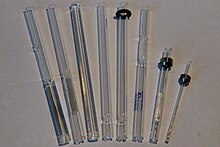Split / splitless injector
A split / splitless injector (abbreviated to S / SL ), also known as split / splitless injector , is a component of a gas chromatograph that is used to introduce the sample into the chromatographic system. In the constantly heated split / splitless injector, the sample is vaporized during or immediately after the injection and mixed with the carrier gas; these injectors therefore belong to the evaporation injectors. Depending on the regulated flow rate through the split outlet, only a portion of the injected sample reaches the separation column. The injector is mainly used with very small internal column diameters (<530 µm), so that usually only a small sample volume (1 to 5 µl) reaches the column.
Forms and working methods
The split / splitless injector can be used in split mode as well as for splitless injection. The regulation of the flow through the split outlet and thus the split ratio can be done manually by means of a valve or by electronic flow control units.
Splitless injection
The split-free injection is suitable for liquid samples, even if there is to be determined or substance to be separated only in traces. With the valve closed, the entire sample volume is first evaporated and then introduced into the separation column. The separation column must be able to accommodate the larger sample volume. Splitless injection is not suitable for gaseous and solid samples.
Split injection
With split injection , the sample enters the separation column while the injector valve is open. This increases the speed of the sample application and improves the resolution. This method is suitable for gaseous, solid and liquid samples that can be vaporized and in which the substance to be determined or separated is not excessively diluted. The quotient of the volume of gas that enters the column from the injector and the total volume of the column is called the split ratio . The split ratios for older devices are between 1:10 and 1: 100, for newer devices between 1: 200 and 1: 300.
See also
Individual evidence
- ^ A b Peter J. Baugh: Gas chromatography: A user-oriented representation , Springer-Verlag , 1997, ISBN 3528066571

